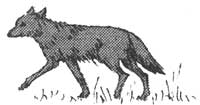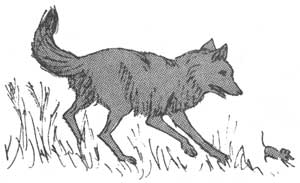COYOTE - NOW YOU SEE HIM, NOW YOU DON'T
Many and sorrowful are the tales of animals such as the grizzly bear
and the ivory-billed woodpecker, who cannot bring themselves to co-exist
with mankind. Their habitats, their peace and quiet -- something they
need -- is crushed by the sheer weight of civilization.

And then there's the coyote. Peace and quiet? Who needs it? There
are, it is estimated, ten thousand coyotes inside the Los Angeles city
limits -- not your basic bucolic surroundings. Habitat? Coyotes prowl
deserts, plains, woodlands and forest margins, farms and suburbia from
sea level to treeline. A map of North America showing coyote habitat is
almost completely crosshatched, and that's a big bunch of habitat
indeed.
Not content to merely co-exist, the coyote thumbs his pointy nose at
mankind. In some areas, we paltry people have done our level best to
eradicate him. In the process we have nearly wiped out the innocuous
little Kit Fox, who kept taking the poisoned bait and gas bombs meant
for coyotes. We've fired tons of ammunition and set a million traps. In
insolent response, the coyote has not only kept his population intact,
he has broadened his range into eastern North America. Coyotes are now
common in Maine, for example, where twenty years ago they were
unknown.
The versatile dog can fend for himself in barren wastes, but he's
equally good at turning a trick in a crowded campground. A ranger at
Cottonwood Campground in Joshua Tree National Monument, some years ago,
watched a coyote work the south loop on a Sunday morning. As the various
camping parties moved around getting breakfast, packing up and lounging,
the coyote wove in and out among vehicles and boulders. He was there --
he enjoyed an ample repast at the campers' expense -- and not a single
camper noticed him. Residents at Tahoma Woods, who rarely see the
critters, hear them yelp and howl regularly.
That famous yelping and howling (which gives the coyote part of its
scientific name, Canis meaning dog and Latrans meaning barking) is
apparently a social occasion as well as a means of communication among
pack members. "Pack" is a misnomer, too, for coyote packs are usually
simply extended families. When next you hear a yelping binge, try to
pick out the smooth, strong adult voices and the querulous voices of the
little guys. Like peach-fuzz choir boys, adolescent coyotes sometimes
lose it in the middle; their voices crack.
Both parents take part in raising their annual litters of six or
seven choir members. The pups, born in spring, are out and on their own
by the time snow flies. The nubile young lady coyotes reach maturity at
about age two.

Another factor in the coyote's ability to make do anywhere is its
appetite, and its predators'. The coyote will eat just about anything;
but very few animals will eat a coyote. Hawks and eagles may pick off an
occasional pup, and poor judgment or accident befall a few, but El
Coyote enjoys relative freedom from enemies. Perhaps, like Charlie the
tuna, coyotes don't have much good taste. They eat carrion eagerly,
small mammals, rarely large mammals (a healthy deer will successfully
resist a family of hunting coyotes, convincing them to find dinner else
where), fruits and berries, even melon -- whatever is handy.
Do they really eat roadrunners? The great Coyote/Roadrunner
confrontation is documented only in the cartoons. But the cartoonists
named the old dog aptly: Wyle E. Coyote. Wily indeed, the thirty-pound
canine is smarter than most domestic dogs. Cases in point: a coyote
deliberately appeared out of the brush a hundred feet in front of a
hefty, seventy-five pound housepet. The dog gave chase, of course, and
failed to notice the two companion coyotes closing in behind him. He was
being decoyed, and planned as the luncheon entree; only timely
intervention by his owner saved him. Had he been smaller, perhaps no
kind of intervention would have saved him, for the same coyotes snatched
a ten-pound miniature poodle even as the owner stood less than thirty
feet away.
At the end, then, it seems to be the coyote's sheer versatility that
carries him so exuberantly through life -- live anywhere, eat anything,
and stay sharp. Here at Mount Rainier the coyotes keep a low profile.
Incidentally, they are harmless, even if their sunset serenades sound as
though Dracula is about to step out from behind a tree. Here they are
protected. In Los Angeles, where aberrant coyotes were blamed for a
child's death, police have orders to shoot coyotes on sight. And yet,
neither here nor there does the coyote population seem to be
changing.
In the Bible, the prophet Isaiah described the once-wealthy, wordly,
sin-laden city of Babylon after her destruction. He told of wild animals
prowling her empty streets, her ruined courts; of jackals (Old World
coyote equivalents) howling from the deserted rooftops. Do you suppose
that after the last Angeleno is gone, and Century City and Universal
Studios have begun to crumble, that the coyotes will still be there?
Sandy Dengler

